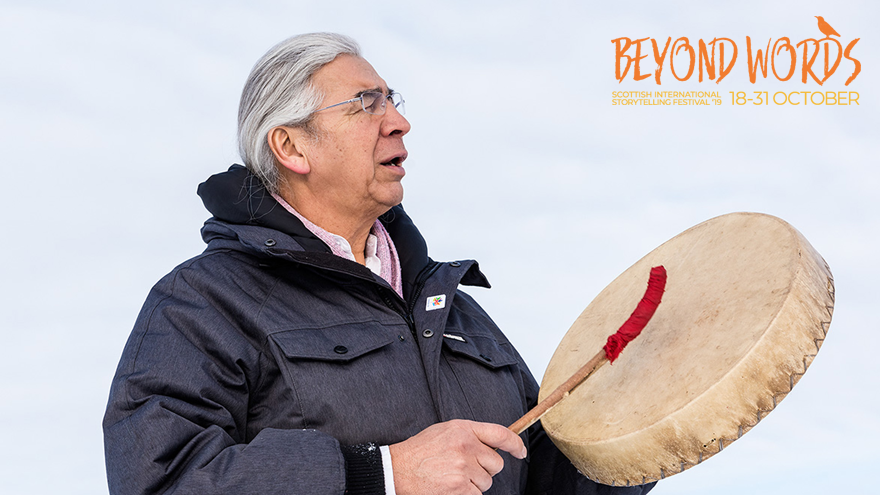Tell us an interesting feature of traditional storytelling in your country.
Traditional storytelling approaches differ across the country. There are 634 First Nations in Canada with 50 distinct languages. Joseph is Nehiyo (or in the anglicized version is ‘Cree’). On the prairies, storytelling is used as a teaching tool, and certain kinds of stories are only told during the winter or when there is snow on the ground.
How did you become a storyteller?
It was a beautiful and transformative experience when I finally arrived in a flow with children – incorporating story, song, teachings and nehiyaw rhythm to my telling. That, to me, is beyond words because my sharing became more exhilarating and natural. I actually had to beg, borrow and appropriate for a time until I began to earn the stories I would share for the next twenty plus years. An elder from Piapot First Nation said to me one day many decades ago that he noticed I speak both languages and that it would be good to talk about the nehiyaw (Cree) culture on behalf of elders. Having returned from thirteen years of residential school, I began spending time with my own community elders when I felt safe and could finally truly believe I’m from there. I began sharing stories in Saskatoon when I realized that children better relate to stories than the conventional ways of sharing indigenous knowledge and information within schools. I’ve come to the conclusion that when there’s been an interruption in one’s life, the ancestral/spiritual lineage returns naturally, if one is open to it. In saying this, I firmly accept that my path was predestined to meet with high teachers from various spiritual disciplines and practices. I spent many years studying with a number of teachers, including a Tibetan Buddhist lama. Once I became reacquainted and reconnected, however, to my culture, the stories, songs and teachings were compelling. I realized that when I had been taken away (scooped in the 1960s along with thousands of other children), there was virtually no way to replace that way of learning or method to absorb that culture within mainstream white/European worldview. In this, I was guided. I had no stories for a time as a result of being scooped, and those were desperate times. Stories are First People’s way of knowing oneself and determining where one comes from. I depended on the short period during which I was told stories, between the ages of 0-5 years and told those to children and adults until I had reacquired my language and various stories from elders through protocol and traditional forms of learning. More recently, I was introduced to elder brother (Cree spiritual storyteller) ten or so years ago and this spirit being has become more prominent in the winter telling that I do.
Do you have a favourite story?
Lately I’ve been enjoying a Blackfoot-Cree conflict story that I’d been gifted by Winston Wuttanee.
This year’s Festival theme is Beyond Words. What does Beyond Words mean for you?
I remember a few times where I was transported, along with the people in the storytelling circle… I remember a young boy who wanted to take me home, a young girl who came right up to me and said very seriously, “Joe, you’re getting old!”, and a teacher who told me I was self effacing and that it’s a good quality to have.
Indigenous culture/language is a focus for SISF 2019: How important is heritage and culture for you? Tell us something in your own language.
nistam kī ayiman ka maci acimoyan kaki moniyahkaskyan… initially it was because I felt like my newly acquired Canadian identity resulting from residential school experience and education created confusion with my original First Nations blood that I had to forget and set aside for thirteen years. maka kahtayaak ni mīnopitikok … then nehiyaw (cree, indigenous and no indigenous) elders/beings greatly influenced me as I was re-introducing and reconnected me to the stories, songs and teachings of the nehiyowak (cree People).
Once I was reintroduced to my spiritual and cultural practice it made a dramatic difference in my storytelling. I became more real, and I felt great that I could and did share the stories and teachings that I’d left as a child. I felt more authentic and truthful.
As part of #SISFBeyondWords, our Global Lab explores the principles and goals of The Earth Charter Initiative and how storytelling can positively impact on this. What do you feel is the role of storytellers in the 21st century?
I believe all storytellers have a responsibility to the state of our world. As a nehiyaw (cree) ceremonialist, I’m committed to creating awareness around mother earth and the changes which occur as a result of human intervention.





